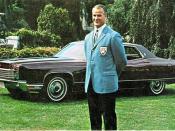Stand By Me is a movie that captivates its viewers with friendships that many of us can relate to. When we were twelve, just as the boys in the movie, our friendships seemed innocent and maybe even trivial to adults, but to us the friendships were the whole world. In this movie we are invited to witness a relationship with four boys growing up in a small town called Castle Rock during the 1950's. Here the boys illustrate friendships with trust, encouragement and reliance. But they do not fit the image our culture may associate with the fifties. The perfect children and perfect families that the media portrayed for us in shows like "Father Knows Best" and "Leave it to Beaver," became the only way many of us viewed families during that era. But Stand By Me illustrates to us how far from perfection the lives for families during the 1950's really were.
The movie starts out with three of the boys talking in their tree house. The forth boy, Vern, arrives out of breath with something obviously important to tell his friends. Finally, he is given the chance to explain to Chris, Gordie, and Teddy what he is so excited about. Vern explains to them that he just overheard his brother talking to someone about how a few days ago they found a dead body of a missing kid in the woods. His brother and friend left the corpse there because they had stolen a car and did not want to face the consequences of getting caught for theft. The four friends decide they are going to make the twenty to thirty mile venture along the railroad tracks and through the woods to find the boy themselves in hopes of becoming heroes and making national television.
The boys make plans to lie to their parents about where they are going to stay that night, but they realize that after they find the dead body their parents will realize that they lied to them and the four boys think they may get in trouble. They conclude that their parents will be so excited about their heroic adventure that they will look past their fault. Chris mentions that he will still get in trouble for lying from his father even though they may become heroes; as a result of his comment, Gordie has a look of worry and it becomes clear that there is more behind Chris's relationship with his dad. Later we find out just how bad it is at home for Chris. His dad is a raging alcoholic, his brother is involved with a gang of teenagers that do nothing but terrorize the city, and there is now mention of his mother. Quickly we start to figure out that the typical fifties family life is a far cry from Chris's family and later we see and hear about the same kind of problems for two of the other boys in their group.
In many of the fifties sitcoms, families are portrayed as very close and spend a lot of time together, but psychologists Goodman and Gurian tell us,
At about age 12, friendships are judged on the basis of understanding and sharing inner thoughts. Preadolescents and adolescents help each other with psychological problems such as fear, loneliness and sadness. By adolescence the time spent with peers is greater than the time spent with adults, including parents.
This is a more realistic view of children and adolescents than the stereotypical adolescent image in many of the 1950's sitcoms. The friends in this movie show this reality and break away from the stereotypical close families. Many of us believe that during the fifties, children ran to their parents when problems arose, but in Stand By Me the boys demonstrate for us that their parents are the last people they want to ask for help. Many times they make references to the horrible things their parents have done to them. Gordie's parents, for instance, ignored him, almost completely, except for when his father was to compare him to his brother, who was a star high school football player, but was killed in a jeep accident. We witness Gordie's mother completely ignoring him and not responding to him when he asks her things.
Often when we think back to the fifties, we may think of the "Leave it to Beaver" family; a family that is well-to-do, money is rarely an issue and worries include things like "what will Beaver get himself into this week?" Never is it mentioned that the children in the show won't amount to anything, nor is it assumed that they are headed in the wrong direction. Becky Bradly tells us, "What was portrayed on television became accepted as normal. The ideal family, the ideal schools and neighborhoods, the world, were all seen in a way, which had only partial basis in reality." Chris's character proves this fifties stereotype wrong as well. Chris's economic status strikes us as lower class. Before Chris even makes claims to money and compares himself to the richer side of town, it is pretty much assumed that he is part of the lower class because of his morals; he smokes, swears profusely, and is considered a thief by many in the movie. Michael Parenti claims, "The entertainment media presents working people not only as unlettered and uncouth but also as less desirable and less moral than other people"(373). Chris knows that society considers upper class kids better than lower class and he call himself a "low life Chambers [his last name] kid."
When Chris discusses with Gordie the issue of him being considered a thief because he stole the milk money at school, he tells Gordie that he gave the money back to his teacher and she stole it from him and bought a new dress with it, which still makes Chris look like a bad guy in the end since the teacher never told anyone that Chris had given the money back. Chris asks Gordie, "Do you think that that bitch would have dared try something like that if it had been one of those douche bags from the View if they had taken it?" (The View is the higher-class side of town.) This idea of a teacher taking advantage of Chris because of his status really upsets him and makes him want to leave Castle Rock to go to place where "no one knows him." Chris represents the "outlaw hero" as Robert Ray puts it, and Chris fits Ray's definition perfectly. Ray says, "Embodied in the adventurer, explorer, gunfighter, wanderer, and loner, the outlaw hero stood for part of the American imagination valuing self-determination and freedom from entanglements" (309). Chris is very much the adventurer in this group, he continually pushes the guys to keep going on their trip, even when it seems dangerous and impossible. And also, as mentioned before, he wants badly to leave Castle Rock, but later we find out that, not only does he want to leave, but he wants to make something of himself.
Another view that many of us may have for the fifties is that many parents loved their children and accepted them for who they were. This movie seems to demonstrate inaccuracy in this belief as well. When Gordie has a flashback to when he and his family are sitting around the dinner table discussing his brother's big football game that was coming up the next day, Gordie distinctly remembers his father not wanting to hear anything about the story he had written. His father didn't care about his writing talent but rather he focused completely on Gordie's older brother's ability to throw a football.
It seems that Gordie's father did not care about Gordie's talents because Gordie did not fit the typical male mold. Gordie is not athletic at all, but is very smart and has other good talents. But education doesn't seem to rate high on his father's scale. Frank Deford says, "No one seemed very upset about Tiger Wood's educational loss when he departed Stanford early"(659). Just as Frank Deford describes society's take on Tiger Wood's decision to play golf rather than to pursue his degree, Gordie's father seem to have the same opinion on what was more important in relation to sports and scholastic talents.
Gordie's father's disapproval continues on to the only important thing in Gordie's life, his friends. Gordie's father tells him that his friends are inadequate because he thinks of Chris as a thief and because of the social class Chris falls under. He asks Gordie why he can not have friends like his older brothers. Gordie tells his father they are not that bad, but his father disagrees with him. Its really important to Gordie to be accepted by his father, but its hard for him to understand why he doesn't like his friends. Later, when Gordie is talking with Chris about the milk money he stole, Gordie finally seems to understand why his dad doesn't like Chris. He realizes it's not because of the money he stole; it's because of the social class he falls under.
Many of us believe that the 1950's were carefree for adolescents and that their lives were straightforward. But these four boys demonstrate anything but untroubled lives. This movie displays the reality of the fifties and helps us to realize that life was just as complicated for adolescents then as it is now. They faced severe family problems, teacher incidents and pressures to succeed and making something of their lives. Though the television sitcoms showed lives of perfection, wonderful families and insignificant problems, we can see that the fifties were a time of complications for adolescents.
Works Cited
Bradly, Becky. "American Cultural History 1950-1959." 1988 Kingwood College Library. 12 Apr. 2004 .
Deford, Frank. "Athletics 101: A changed in Eligibility Rules is Long Overdue." National Public Radio. N.d. Rpt. in Signs of Life in the USA: Readings on Popular Culture for Writers. By Sonia Massik and Jack Solomon. 4th ed. Boston: Bedford/St. Martin's, 2003. 659-660.
Goodman, Robin F, and Anita Gurian. "Friends and Friendships." 2 Dec. 2000 NYU Child Study Center: Changing the Face of Child Mental Health." 4 Apr. 2004. .
Parenti, Michael. "Calls and Virtue." Make Believe Media. 1st ed. in Signs of Life in the USA: Readings on Popular Culture for Writers. BySonia Massik and Jack Solomon. 4th ed. Boston: Bedford/St. Martin's, 2003. 373-376.
Ray, Robert. "The Thematic Paradigm." A Certain Tendency of the Hollywood Cinema 1930-1980. in Signs of Life in the USA: Readings on Popular Culture for Writers. By Sonia Massik and Jack Solomon. 4th ed. Boston: Bedford/St. Martin's, 2003. 308-315.



1950's
This is a well researched essay focusing on the movie "Stand By Me" and what it reveals not only about growing up but also about a decade which is quickly becoming forgotten for many. I'm sure a number of us can relate to the problems of growing up which the boys in the movie faced. The problems are not unique to any particular decade and we often look back with nostalgia at times gone by which weren't as pleasant as we would like to remember.
6 out of 6 people found this comment useful.